Complete Solutions to TOPIC:2- SHORT ANSWER TYPE QUESTIONS-II of chapter PERIODIC CLASSIFICATION OF ELEMENTS of Class 10 book with complete answers and questions
| Class 10 | CHEMISTRY |
| Chapter | PERIODIC CLASSIFICATION OF ELEMENTS |
| OSWAAL PUBLICATION | TOPIC:2- SHORT ANSWER TYPE QUESTIONS-II |
| Number Of Questions | 45 |
| Academic Year | 2023-24 |
The atomic numbers of two elements A and B are 11 and 12 respectively. Which element exhibits highest metallic property ? Why ? Write the molecular formula of the compounds formed when these elements combine with the element 'Z' having atomic number 8.
View SolutionThe atomic numbers of five elements A, B, C, D and E are 6, 8, 3, 7 and 9 respectively.
(i) Which is the element having the highest electropositivity among these elements ? Why?
(ii) Which is the element having the least metallic character among these elements ? Why?
(iii) What is your conclusion about the relationship between metallic character and electropositivity of an element ?
View SolutionWhat is meant by atomic radius ? Explain why it decreases across a period ?
View Solutiona] Name the element with atomic number 17.
b]To which period does it belong?
c]To which group does it belong?
d]Write its electronic configuration.
View Solution"Electronegativity is the case of gaining electrons".
(a) Which type of elements will have high electronegativity ?
(b) How does electronegativity change as we move
(i) across a period
(ii) down a group ?
View SolutionHow many groups and periods are there in the modern periodic table? How do the atomic size and metallic character of elements vary as we move ?
(i) down a group and
(ii) from left to right in a period.
View SolutionWrite the number of periods the modern periodic table has. State the changes in valency and metallic character of elements as we move from left to right in a period. Also state the changes, if any, in the valency and atomic size of elements as we move down a group.
View Solution(a) Define the following terms:
(i) Valency, (ii) Atomic size.
(b) How do the valency and the atomic size of the elements vary while going from left to right along a period in the modern periodic table ?
View SolutionWhat is meant by a group in the Modern Periodic Table? How do the following change on moving from top to bottom in a group?
i] Number of valence electrons
ii] Number of occupied shells
iii] Size of atoms
iv] Metallic character of elements
v] Effective nuclear charge experienced by valence electrons
View SolutionName:
a) three elements that have a single electron in their outermost shells
b) two elements that have two electrons in their outermost shells .
c) three elements with filled outermost shells
View SolutionCalcium is an element with atomic number 20. Stating reason for each of the following questions :
(i) Is calcium a metal or non-metal ?
(ii) Will its atomic radius be larger or smaller than that of potassium with atomic number 19 ?
(iii) Write the formula of its oxide.
View SolutionName any two elements of group one and write their electronic configurations. What similarity do you observe in their electronic configurations ? Write the formula of oxide of any of the above said element.
View SolutionAn element 'M' with electronic configuration (2,8,2) combines separately with `NO_(3)^(-),SO_(4)^(2-)andPO_(4)^(3-)` radicals. Write the formula of the three compounds so formed. To which group and period of the modern periodic table does the element 'M' belong ? Will 'M' form covalent or ionic compounds? Give reason to justify your answer.
View SolutionTwo elements P and Q belong to the 3rd period of the Modern Periodic Table and are in group 1 and 2 respectively. Compare their following characteristics in tabular form:
i] The number of electron in their atoms
ii] The size of their atoms
iii] Their metallic character
iv] Their tendencies to lose electrons
v] The formula of their oxides
vi] The formula of their chlorides.
View SolutionAn element 'X' (Atomic number = 20) burns in the presence of oxygen to form a basic oxide.
(i) Identify the element and write its electronic configuration.
(ii) State its group number and period number in the Modern Periodic Table.
(iii) Write a balanced chemical equation for the reaction when this oxide is dissolved in water.
View SolutionAn element 'X' belongs to third period and second group of the Modern Periodic Table.
(i) Write its electronic configuration.
(ii) Is it a metal or non-metal? Why?
(iii) Write the formula of the compound formed when 'X' reacts with an element
(a) Y of electronic configuration 2, 6 and (b) Z with electronic configuration 2, 8, 7.
View SolutionThe atomic number of an element 'X' is 19.
(i) Write its electronic configuration.
(ii) To which period of the Modern Periodic Table does it belong and what is its valency?
(iii) If 'X' burns in oxygen to form its oxide, what will be its nature - acidic, basic or neutral ?
(iv) Write balanced chemical equation for the reaction when this oxide is dissolved in water.
View SolutionAn element 'X' belongs to the 3rd period and group 16 of the Modern Periodic Table.
a) Determine the number of valence electrons and the valency of 'X'.
b] Write the molecular formula of the compound when X reacts with hydrogen and write its electron-dot structure.
c] Name the element X and state whether it is metallic or non-metallic
View SolutionAn element X has mass number 35 and number of neutrons = 18. Write atomic number and electronic configuration of X. Also write group number, period number and valency of X.
View SolutionThree elements 'X', 'Y' and 'Z' have atomic numbers 7, 8 and 9 respectively.
(i) State their positions (Group number and period number both) in the Modern Periodic Table.
(ii) Arrange these elements in the decreasing order of their atomic radii.
(iii) Write the formula of the compound formed when 'X' combines with 'Z'.
View SolutionThe position of eight elements in the modern periodic table is given below where atomic numbers of elements are given in the parenthesis.

(i) Write the electronic configuration of Ca.
(ii) Predict the number of valence electrons in Rb.
(iii) What is the number of shells in Sr ?
(iv) Predict whether K is a metal or a non-metal.
(v) Which one of these elements has the largest atom in size ?
(vi) Arrange Be, Ca, Mg and Rb in the increasing order of the size of their respective atoms.
View SolutionFour elements A, B, C and D have atomic numbers 12, 13, 14 and 15 respectively.
Answer the following questions giving reasons :
(i) What is the number of valence electrons and valency of D?
(ii) Which of them will have largest atomic radii ?
(iii) Which of these elements will form the most basic oxide ?
View SolutionFrom the following elements :
`_(4)Be,_(9)F,_(19)K,_(20)Ca`
(i) Select the element having one electron in the outermost shell.
(ii) Two elements of the same group.
Write the formula and mention the nature of the compound formed by the union of `_(19)K` and element X (2,8,7).
View SolutionNa, Mg and Al are the elements of the same period of modern periodic table having one, two and three valence electrons respectively. Which of these elements (i) has the largest atomic radius, (ii) is least reactive ? Justify your answer stating reason for each case.
View SolutionThe elements `_(4)Be,_(12)Mgand_(20)Ca` each having two, valence electrons in their valence shells are in periods 2, 3 and 4 respectively of the modern periodic table. Answer the following questions associated with these elements, giving reason in each case,
(i) In which group should they be?
(ii) Which one of them is least reactive ?
(iii) Which one of them has the largest atomic size ?
View SolutionTwo elements 'P' and 'Q' belong to the same period of the modern periodic table and are in Group -1 and Group -2 respectively. Compare their following characteristics in tabular form:
(i) The number of electrons in their atoms
(ii) The sizes of their atoms
(iii) Their metallic characters
(iv) Their tendencies to lose electrons
(v) The formula of their oxides
(vi) The formula of their chlorides
View SolutionThe atomic number of an element 'X' is 20.
(i) Determine the position of the element 'X' in the periodic table.
(ii) Write the formula of the compound formed when 'X' reacts/combines with another element 'Y' (atomic number 8).
(iii) What would be the nature (acidic or basic) of the compound formed ? Justify your answer.
View SolutionFour elements P, Q, R and S belong to the third period of the Modern Periodic Table and have respectively 1,3,5 and 7 electrons in their outermost shells. Write the electronic configurations of Q and R and determine their valencies. Write the molecular formula of the compound formed when P and S combine.
View SolutionIn the following table, the positions of six elements A, B, C, D, E and F are given as they are in the Modern Periodic Table :

On the basis of the above table, answer the following questions :
(i) Name the element which forms only covalent compounds.
(ii) Name the element which is a metal with valency three.
(iii) Name the element which is a non-metal with valency three.
(iv) Out of B and C, whose atomic radius is bigger and why?
(v) Write the common name for the family to which the elements D and F belong.
View SolutionThe electrons in the atoms of four elements A, B, C and D are distributed in three shells having 1, 3, 5 and 7 electrons in the outermost shell respectively. State the period in which these elements can be placed in the modern periodic table. Write the electronic configuration of the atoms of A and D and the molecular formula of the compound formed when A and D combine.
View SolutionBased on the group valency of elements state the formula for the following giving justification for each :
(i) Oxides of `1^(st)` group elements,
(ii) Halides of the elements of group 13, and
(iii) Compounds formed when an element of group 2 combines with, an element of group 16.
View SolutionConsider two elements ‘A’ (Atomic number 17) and 'B' (Atomic number 19):
(i) Write the positions of these elements in the modern periodic table giving justification.
(ii) Write the formula of the compound formed when 'A' combines with 'B.'
(iii) Draw the electron dot structure of the compound and state the nature of the bond formed between the two elements.
View SolutionStudy the following table in which positions of six elements A, B, C, D, E and F are shown as they are in the modern periodic table :
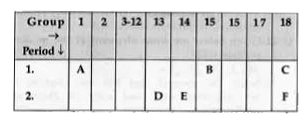
On the basis of the above table, answer the following questions :
(i) Name the element which forms only covalent compounds.
(ii) Name the element which is a metal with valency three.
(iii) Name the element which is a non-metal with valency three.
(iv) Out of D and E, which is bigger is size and why ?
(v) Write the common name for the family to which the elements C and F belong.
View SolutionThe elements Li, Na and K, each having one valence electron, are in period 2, 3 and 4 respectively of modern periodic table.
(1) In which group of the periodic table should they be?
(ii) Which one of them is least reactive ?
(iii) Which one of them has the largest atomic radius?
Give reason to justify your answer in each case.
View SolutionAn atom has electronic configuration 2, 8, 2.
(i) What is the atomic number of this element ?
(ii) What is its valency ?
(iii) To which of the following elements would it be chemically similar and why ? (Be-4, 0-8. Justify your answer.)
View SolutionTwo elements X and Y belong to group 1 and 2 respectively in the same period of the periodic table. Compare these elements with respect to :
(i) number of electrons in their outermost orbit
(ii) their valencies
(iii) metallic character
(iv) their atomic size
(v) formula of their chlorides
(vii) formula of their sulphates.
View SolutionFour elements A, B, C and D along with their electronic configuration are given below:

Now answer the following questions:
(i) Which two elements belong to the same period ?
(ii) Which two elements belong to the same group ?
(iii) Which element out of A and C is more reactive and why?
View SolutionFour elements A, B, C and D have atomic numbers 12, 13, 14 and 15 respectively.
Answer the following questions giving reasons :
(i) What is the number of valence electrons and valency of D?
(ii) Which of them will have largest atomic radii ?
(iii) Which of these elements will form the most basic oxide ?
View SolutionThree elements X, Y and Z have atomic numbers 7, 10 and 14 respectively.
(i) Identify the group number of these elements in the periodic table.
(ii) Mention one unique feature each of elements Y and Z.
(iii) Which of the above two elements belong to the same period ?
View SolutionFrom the following part of the periodic table, answer the following questions:
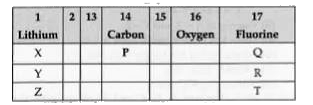
(i) Which is the most reactive metal ?
(ii) Name the family of fluorine Q, R, T.
(iii) Name one element each of group 2 and 15.
(iv) Give the name of the element P placed below carbon.
(v) Compare X and P with respect to the size of atoms.
View SolutionThe position of three elements A, B and C in the periodic table are shown below :
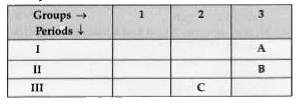
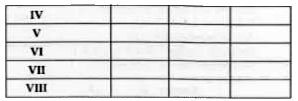
Give reasons to explain the following:
(i) Element 'A' is a metal.
(ii) Element 'B' has larger size than 'C'.
(iii) Element 'C' has a valency - 3.
View SolutionGiven below are some elements of the Modern Periodic Table:
`""_(4)Be, ""_(26)Fe.""_(14)Si, ""_(19)K ""_(20)Ca`
i) Select the element that has one electron in the outermost shell and write its electronic configuration.
ii) Select two elements that belong to the same group. Give reason.
iii) Select two elements that belong to the same period. Which one of the two has a bigger atomic size?
View SolutionWrite the number of period the modern periodic table has. How do the valency and metallic character of elements vary on moving from left to right in a period ? How do the valency and atomic size of elements vary down a group ?
View SolutionAn element X (atomic number 17) reacts with an element Y (atomic number 20) to form a compound.
(i) Write the position of these elements in the modern periodic table.
(ii) Write the formula of the compound formed. Justify your answer in each case.
View Solution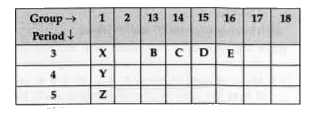
Using the given part of the periodic table, answer the following questions with reason :
(i) Name the element having smallest atomic size.
(ii) Write electronic configuration of element E.
(iii) Identify the elements which have similar physical and chemical properties as the element Y.
View Solution
TOPIC:2- SHORT ANSWER TYPE QUESTIONS-II questions and complete solutions for chapter PERIODIC CLASSIFICATION OF ELEMENTS of OSWAAL CHEMISTRY (KANNADA ENGLISH) of Class 10
All Exercises from OSWAAL PUBLICATION Class 10 CHEMISTRY PERIODIC CLASSIFICATION OF ELEMENTS
- NCERT CORNER - TEXTBOOK EXERCISES
- NCERT CORNER -INTEXT QUESTIONS
- TOPIC:1- LONG ANSWER TYPE QUESTIONS
- TOPIC:1- MATCH THE COLUMN
- TOPIC:1- MULTIPLE CHOICE QUESTIONS
- TOPIC:1- SHORT ANSWER TYPE QUESTIONS-I
- TOPIC:1- SHORT ANSWER TYPE QUESTIONS-II
- TOPIC:1- VERY SHORT ANSWER TYPE QUESTIONS
- TOPIC:1-MULTIPLE CHOICE QUESTIONS
- TOPIC:2- LONG ANSWER TYPE QUESTIONS
- TOPIC:2- SHORT ANSWER TYPE QUESTIONS-II
- TOPIC:2- VERY SHORT ANSWER TYPE QUESTIONS
- TOPIC:2-MULTIPLE CHOICE QUESTION
- TOPIC:2-SHORT ANSWER TYPE QUESTIONS-I